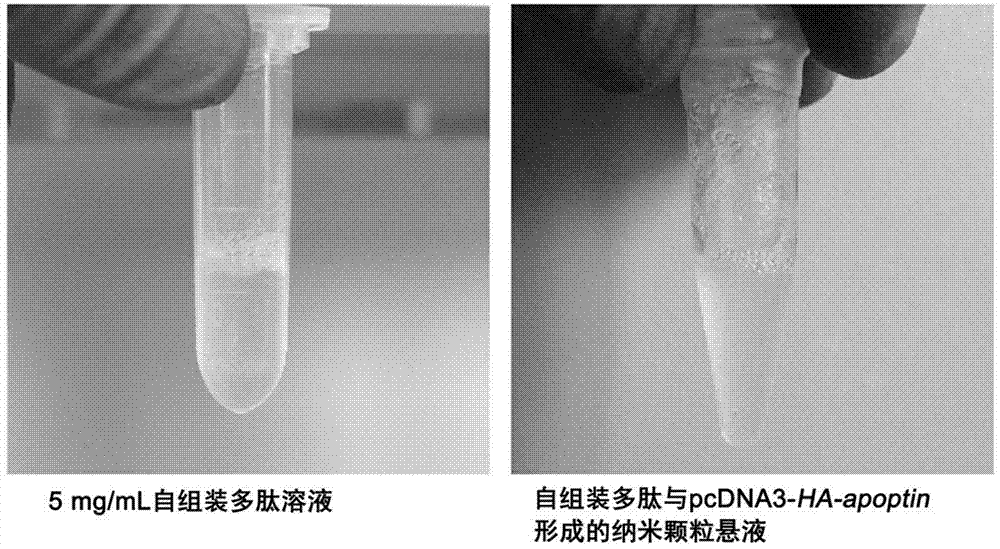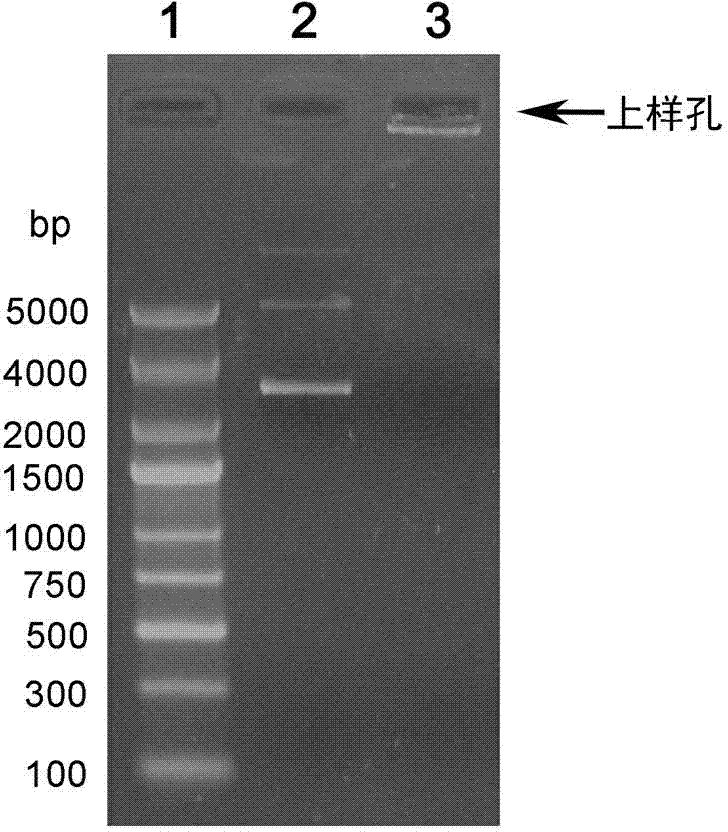Self-assembled polypeptide-apoptin gene composite nanoparticle, and preparation method and application thereof
A composite nanoparticle and nanoparticle technology are applied in the field of self-assembled polypeptide-apoptin gene composite nanoparticles and their preparation to achieve the effect of overcoming the lack of targeting of therapeutic genes
- Summary
- Abstract
- Description
- Claims
- Application Information
AI Technical Summary
Problems solved by technology
Method used
Image
Examples
preparation example Construction
[0034] The preparation method of the self-assembling polypeptide-apoptin gene composite nanoparticle of the present invention comprises the following steps:
[0035] (1) According to the sequence of SEQ No.1, synthesize the self-assembling polypeptide;
[0036] (2) Construction of pcDNA3- HA - apoptin Plasmid: Design and custom synthesis with pcDNA3 as vector HA - apoptin Primers to pcDNA3- apoptin as a template, amplified HA - apoptin Target gene fragment, construct pcDNA3- HA - apoptin plasmid; HA - apoptin The primer sequences are as follows:
[0037] HA - apoptin Upstream primers (underlined as Bam HI restriction site):
[0038]
[0039] Bam HI and xho I Double digestion plasmid vector pcDNA3 and target gene HA - apoptin , in the vector pcDNA3 multiple cloning site Bam HI and xho Access at I HA - apoptin Gene fragment; T4 DNA ligase at 16°C, 12h to connect the vector and the target gene fragment to obtain recombinant pcDNA3- HA - ...
Embodiment 1
[0046] Example 1: Construction of recombinant pcDNA3- HA - apoptin eukaryotic expression plasmid
[0047] Step 1: PCR Amplification HA - apoptin Gene
[0048] 10×Taq Buffer 5 μL 2 mM dNTPs 5 μL 1 μM upstream primer 1 μL 1 μM downstream primer 1 μL template 2 μL 25 mM Mg 2+ 2.5 μL Taq DNA Polymerase 1.3 μL h 2 o 32.2 μL total: 50 μL
[0049] in, HA - apoptin The primer sequences are as follows:
[0050] HA - apoptin Upstream primers (underlined as Bam HI restriction site):
[0051]
[0052] The PCR reaction program was: 95°C preheating for 300s, 95°C for 30s→55°C for 30s→72°C for 40s, 35 cycles, 72°C for 300s, 4°C for 1h.
[0053] Step 2: Recovery using Omega Biotek Kit HA - apoptin PCR product;
[0054] Step 3: HA-apoptin The gene fragment was inserted into the vector pcDNA3
[0055] pcDNA3 HA-apoptin xho I 1 μL xho I 1 μL Bam HI 1μL Bam HI 1...
Embodiment 2
[0063] Example 2: Preparation of self-assembling polypeptide-apoptin gene composite nanoparticles
[0064] The self-assembling polypeptide was synthesized according to the sequence SEQ No.1, and the synthesized self-assembling polypeptide was in the form of white powder, which was prepared into a 5.26 mg / mL self-assembling polypeptide solution. The preparation process is to take 0.95 mL sterile PBS (pH7.4) buffer solution in an ultra-clean bench, weigh 5 mg of self-assembled peptide powder, mix and dissolve it, place it in an ice-water bath, and use ultrasonic waves to aid in dissolution, with an ultrasonic power of 4 W / mL, work for 3 s each time, stop for 5 s, and the total duration of aiding solution is 20 min.
[0065] Take 0.95 mL of 5.26 mg / mL self-assembling peptide solution, add 2 μg / μL pcDNA3- HA - apoptin The plasmid solution is 50 μL, the total volume of the mixed solution is 1 mL, the final mass concentration of the polypeptide is 5 mg / mL, the final mass concentr...
PUM
| Property | Measurement | Unit |
|---|---|---|
| Length | aaaaa | aaaaa |
| Diameter | aaaaa | aaaaa |
Abstract
Description
Claims
Application Information
 Login to View More
Login to View More - R&D
- Intellectual Property
- Life Sciences
- Materials
- Tech Scout
- Unparalleled Data Quality
- Higher Quality Content
- 60% Fewer Hallucinations
Browse by: Latest US Patents, China's latest patents, Technical Efficacy Thesaurus, Application Domain, Technology Topic, Popular Technical Reports.
© 2025 PatSnap. All rights reserved.Legal|Privacy policy|Modern Slavery Act Transparency Statement|Sitemap|About US| Contact US: help@patsnap.com



